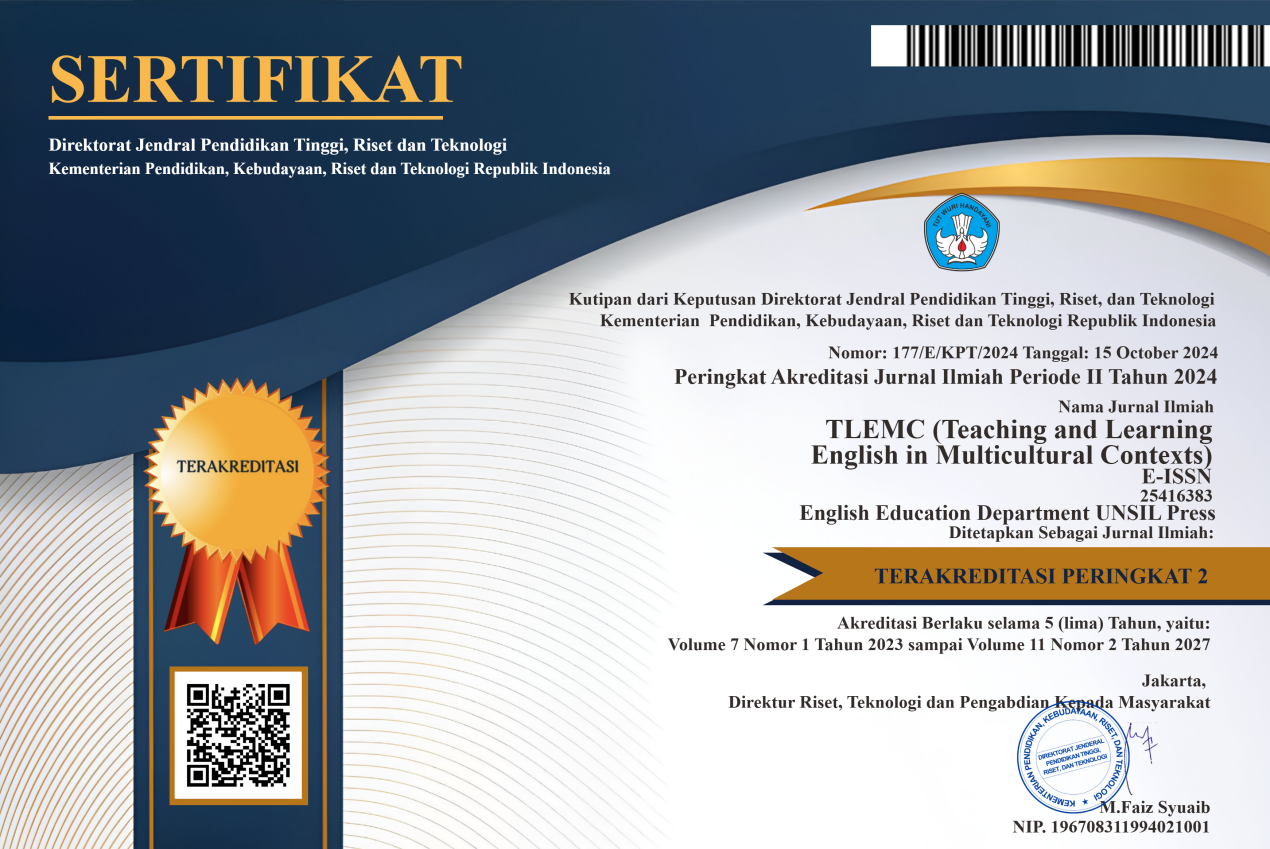Sentence Errors in Descriptive Text: A Study on How Students Understand English Sentence Patterns
Abstract
This research is addressed to discover the mistakes carried out by the students in writing simple sentences and complex sentences of descriptive text in the form of description paragraph. The research participants are undergraduate students of the first semester. The research objective is identifying kinds of sentence errors in simple sentences and complex sentences conducted by the students in writing a descriptive paragraph. The research data were obtained from the results of the questionnaires. The data tells that, firstly, 96% of total students did not come from a language major when they were in high school y are and tests given; secondly, 63% of students learn English in one week more than once (generally 2x80 minutes), and thirdly, only 29% of students admit to having studied very ‘complex’ sentences. Furthermore, the study identifies three types of students’ mistakes related to writing simple sentences. Those mistakes are: 1) mistakes in using the verb form from the review of the English structure and of conformity to the subject of the sentence, 2) the use of types of words in the subject and or subject complement, and 3) the incompleteness of elements in simple sentences (no subject, or verbs, and or subject complement). In relation to the ability of writing complex sentences, there were four types of common mistakes related to complex sentences. They are: 1) mistakes in placing complementary clauses according to the type of clause, 2) incomplete sentence elements, both in the main clause and in complementary clauses, 3) mistakes in using types of words in certain parts, both in the main and complementary clauses, and 4) mistakes in using conjunctions. Based on the research results, the researcher concludes that the ability to write complex sentences should be of greater concern both students and lecturers for better writing ability.Â
Full Text:
PDFReferences
AAdaninggar Septi Subekti. (2017). A Study of the Mastery of Complex Sentences of Pre-Service English Teachers. Ahmad Dahlan Journal of English Studies (ADJES) Vol.4, No.2, pp. 21- 26 ISSN: 2356-5012
Bhatta, V. P. (1991). Epistemology, Logic and Grammar (Analysis of Sentence Meaning) Vol 1., ASTERN BOOK LINKERS .5825, New Cbandrawal, Jawabar Nagar,DELHI•1l0007, p. 21
Asmayanti and Ardi (2021). The Students’ Writing Proficiency in Descriptive Paragraph with Personal Photograph, Exposure Journal, Vol. 6 No. 1, p. 55
Alexandra-Valeria Popescu et al. (2015). How to Teach Paragraph Writing in a Foreign Language, Procedia - Social and Behavioral Sciences 191, pp. 1213 – 1217
Datchuk, Shawn M. (10 September 2015). Writing Simple Sentences and Descriptive Paragraphs: Effects of an Intervention on Adolescents with Writing Difficulties, J Behav Educ. Retrieved from DOI 10.1007/s10864-015-9236-x
Halliday, MAK (2000). An Introduction to Functional Grammar. Beijing: Foreign Language Teaching and Research Press
Hanna Sundari. (2013, May). Mastery of Simple Sentence Patterns in Writing Class (A Case Study of Third Semester College-Students). Indraprasta PGRI University. Retrieved from https://www.researchgate.net/publication/317951860
Harmer, J. (2007). The Practice of English Language Teaching. 4th ed. London: Longman.
Jones, Linda K. (1977). Theme in English Expository Discourse in Language Culture and Cognition, Edward Sapir Monograph Series. Lake Bluff: Jupiter Press
Juzwiak, Christ (2012). Stepping Stones A Guided Approach to Writing Sentences and Paragraphs Second Edition. Bedfort/St. Martins, Boston New York, p. 4
Hirtle, W. H. (2017). The Word and Its Ways in English: Essays on the Parts of Speech and Person, © McGill-Queen’s University Press
Marjolijn Verspoor and Kim Sauter. (2006). English Sentence Analysis An Introductory Course. University of Groningen Bueno, A, D. Madrid and N. McLaren, (eds). TEFL in Secondary Education. Granada: Editorial Universidad de Granada
Mehmet Demirezen. (2013). The recognition of extended simple sentences as a teaching writing problem. Hacettepe University, English Language Education, Ankara, Turkey Procedia - Social and Behavioral Sciences (70) 560 - 566
Sabry, Ayman Daif-Allah and Khaled Albesher. (2013). The Use of Discourse Markers in Paragraph Writings: The Case of Preparatory Year Program Students in Qassim University, English Language Teaching; Vol. 6, No. 9. ISSN 1916-4742 E-ISSN 1916-4750
Williamson, Lisa, and Paul (2018). Research Methods: Information, Systems, and Contexts. Retrieved from DOI: http://dx.doi.org/10.1016/B978-0-08-102220-7.00019-4, Elsevier Ltd.
DOI: https://doi.org/10.37058/tlemc.v5i1.3148
Refbacks
- There are currently no refbacks.
INDEXED BY:
This work is licensed under a Creative Commons Attribution-NonCommercial-ShareAlike 4.0 International License.
![]()
TLEMC (Teaching and Learning English in Multicultural Contexts)
Program Studi Pendidikan Bahasa Inggris
Fakultas Keguruan dan Ilmu Pendidikan
Universitas Siliwangi
Jl. Siliwangi No. 24 Kota Tasikmalaya - 46115
email: tlemc@unsil.ac.id





